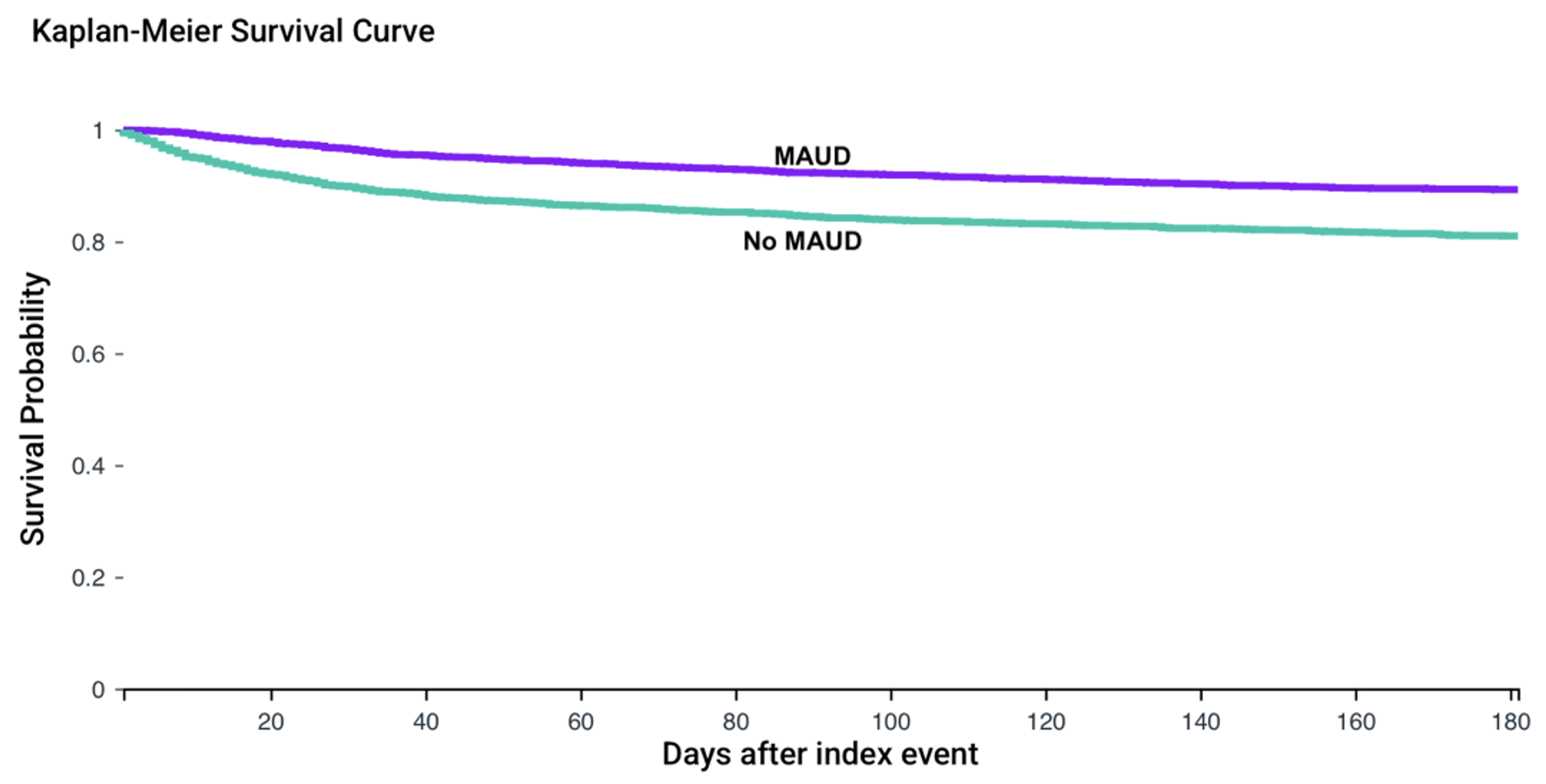Sunday Poster Session
Category: Liver
P1489 - Medications for Alcohol Use Disorder Improve Survival in Patients With Alcohol-Associated Hepatitis
Sunday, October 26, 2025
3:30 PM - 7:00 PM PDT
Location: Exhibit Hall

Abdelkader Chaar, MD
SUNY Upstate Medical University
Syracuse, NY
Presenting Author(s)
Abdelkader Chaar, MD, Sharifeh Almasaid, MD, MPH, Ahmad Nawaz, MBBS, Prerna Ashok Kherajani, MBBS, Savio John, MD, FACG
SUNY Upstate Medical University, Syracuse, NY
Introduction: Addressing alcohol use disorder (AUD) is a paramount step in the management of alcohol-associated liver diseases. Emerging data are suggestive of improved outcomes in patients with alcohol-associated cirrhosis when prescribed medications for alcohol use disorder (MAUD), such as naltrexone or acamprosate. However, data on the use of MAUD in alcohol-associated hepatitis (AH) are lacking. In this study, we aim to assess outcomes of AH in patients who are receiving MAUD.
Methods: We conducted a retrospective cohort study using TriNetX, a global multi-institutional federated research database, on adults (≥18 years) diagnosed with AH over a 20-year period from May 2004 to April 2024. Patients were divided into two groups: those who were prescribed naltrexone or acamprosate within 1 month of AH diagnosis and those who were not. To control for confounders, 1:1 propensity score matching was performed based on age, sex, and medical comorbidities. We excluded patients with viral hepatitis, Wilson’s disease, autoimmune hepatitis, or obstructive jaundice. Matched cohorts were analyzed for 6-month outcomes.
Our primary outcome was all-cause mortality. Secondary outcome assessed liver transplantation at 6 months. Adjusted odds ratios (aORs) with 95% confidence intervals (CIs) were calculated.
Results: We identified 44,694 patients with AH, of whom 2,468 (5.51%) were exposed to MAUD within the first month of AH diagnosis. Patients with MAUD were younger (mean age 43.1 vs. 47.6 years; p < 0.001). Propensity score matching resulted in 2,464 patients in each group. Those who were exposed to MAUD had 50% lower rates of mortality when compared to those who were not (aOR 0.503, 95% CI 0.42-0.59). Rates of liver transplantation were low and similar in both groups (aOR 0.635, 95% CI 0.38-1.05). (Table and Figure).
Discussion: Our study highlights an alarmingly low utilization of MAUD in AH patients, yet we found significantly better survival in those who were exposed to MAUD within 1 month of AH diagnosis. This is a reflection of the importance of early interventions to address underlying AUD in this patient population. Efforts should be directed to improve access and raise awareness about the safety and efficacy of MAUD in treating AUD in patients with AH.

Figure: Table: Summary of outcomes.
Abbreviations: AH: Alcohol-associated hepatitis; MAUD: Medications for alcohol use disorder.

Figure: Figure: Kaplan Meier curve showing the 6-month survival of alcohol-associated hepatitis patients who are on MAUD compared to those who are not.
Abbreviations: MAUD: Medications for alcohol use disorder.
Disclosures:
Abdelkader Chaar indicated no relevant financial relationships.
Sharifeh Almasaid indicated no relevant financial relationships.
Ahmad Nawaz indicated no relevant financial relationships.
Prerna Ashok Kherajani indicated no relevant financial relationships.
Savio John indicated no relevant financial relationships.
Abdelkader Chaar, MD, Sharifeh Almasaid, MD, MPH, Ahmad Nawaz, MBBS, Prerna Ashok Kherajani, MBBS, Savio John, MD, FACG. P1489 - Medications for Alcohol Use Disorder Improve Survival in Patients With Alcohol-Associated Hepatitis, ACG 2025 Annual Scientific Meeting Abstracts. Phoenix, AZ: American College of Gastroenterology.
SUNY Upstate Medical University, Syracuse, NY
Introduction: Addressing alcohol use disorder (AUD) is a paramount step in the management of alcohol-associated liver diseases. Emerging data are suggestive of improved outcomes in patients with alcohol-associated cirrhosis when prescribed medications for alcohol use disorder (MAUD), such as naltrexone or acamprosate. However, data on the use of MAUD in alcohol-associated hepatitis (AH) are lacking. In this study, we aim to assess outcomes of AH in patients who are receiving MAUD.
Methods: We conducted a retrospective cohort study using TriNetX, a global multi-institutional federated research database, on adults (≥18 years) diagnosed with AH over a 20-year period from May 2004 to April 2024. Patients were divided into two groups: those who were prescribed naltrexone or acamprosate within 1 month of AH diagnosis and those who were not. To control for confounders, 1:1 propensity score matching was performed based on age, sex, and medical comorbidities. We excluded patients with viral hepatitis, Wilson’s disease, autoimmune hepatitis, or obstructive jaundice. Matched cohorts were analyzed for 6-month outcomes.
Our primary outcome was all-cause mortality. Secondary outcome assessed liver transplantation at 6 months. Adjusted odds ratios (aORs) with 95% confidence intervals (CIs) were calculated.
Results: We identified 44,694 patients with AH, of whom 2,468 (5.51%) were exposed to MAUD within the first month of AH diagnosis. Patients with MAUD were younger (mean age 43.1 vs. 47.6 years; p < 0.001). Propensity score matching resulted in 2,464 patients in each group. Those who were exposed to MAUD had 50% lower rates of mortality when compared to those who were not (aOR 0.503, 95% CI 0.42-0.59). Rates of liver transplantation were low and similar in both groups (aOR 0.635, 95% CI 0.38-1.05). (Table and Figure).
Discussion: Our study highlights an alarmingly low utilization of MAUD in AH patients, yet we found significantly better survival in those who were exposed to MAUD within 1 month of AH diagnosis. This is a reflection of the importance of early interventions to address underlying AUD in this patient population. Efforts should be directed to improve access and raise awareness about the safety and efficacy of MAUD in treating AUD in patients with AH.

Figure: Table: Summary of outcomes.
Abbreviations: AH: Alcohol-associated hepatitis; MAUD: Medications for alcohol use disorder.

Figure: Figure: Kaplan Meier curve showing the 6-month survival of alcohol-associated hepatitis patients who are on MAUD compared to those who are not.
Abbreviations: MAUD: Medications for alcohol use disorder.
Disclosures:
Abdelkader Chaar indicated no relevant financial relationships.
Sharifeh Almasaid indicated no relevant financial relationships.
Ahmad Nawaz indicated no relevant financial relationships.
Prerna Ashok Kherajani indicated no relevant financial relationships.
Savio John indicated no relevant financial relationships.
Abdelkader Chaar, MD, Sharifeh Almasaid, MD, MPH, Ahmad Nawaz, MBBS, Prerna Ashok Kherajani, MBBS, Savio John, MD, FACG. P1489 - Medications for Alcohol Use Disorder Improve Survival in Patients With Alcohol-Associated Hepatitis, ACG 2025 Annual Scientific Meeting Abstracts. Phoenix, AZ: American College of Gastroenterology.

